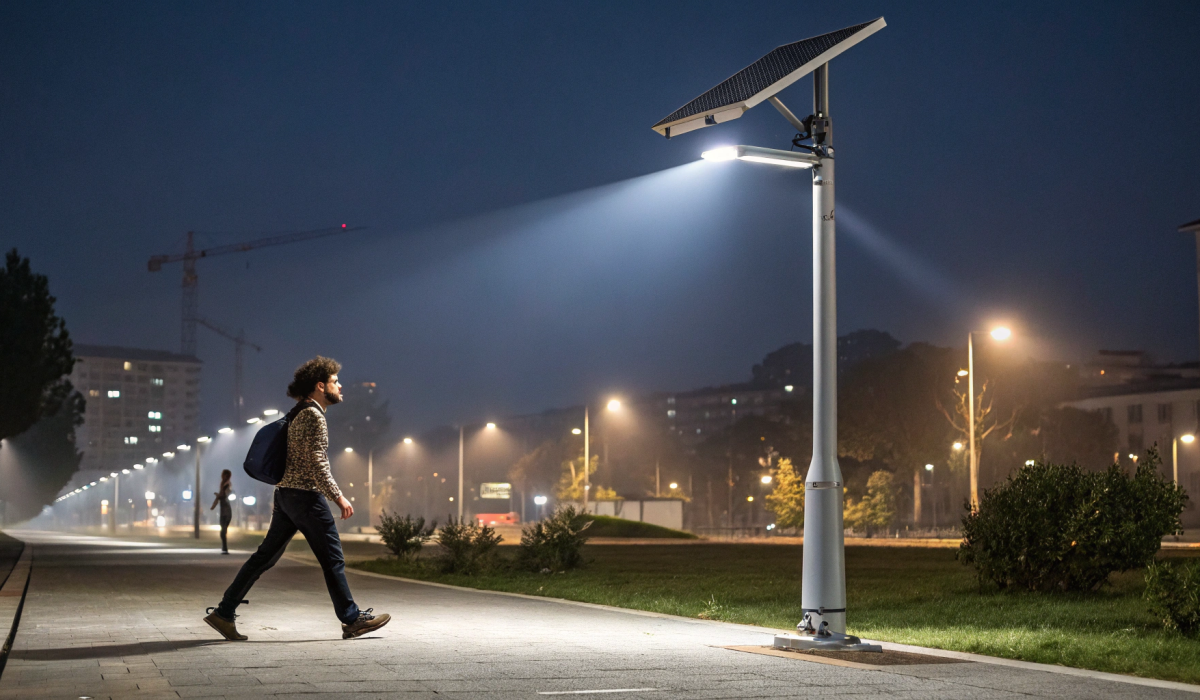Sensors play a crucial role in optimizing the performance of solar street lights. The right sensor selection improves energy efficiency[^1], lighting control, and system longevity.
From light sensors to motion detectors, each type serves a unique function in enhancing street lighting automation and performance.
Technological advancements have transformed solar street lights into smart lighting solutions. Sensor-equipped solar street lights are essential for energy conservation, smart city development, and reliable nighttime illumination.
Types of Sensors Used in Solar Street Lights
Different sensors provide varied functionalities, ranging from automatic brightness adjustment to motion detection.
Time Controller
- Function: Controls the switching and brightness of street lights based on preset time periods.
- Modes: Single-time, dual-time, and multi-time control settings.
- Benefits:
- Reduces unnecessary energy consumption.
- Extends battery life and lowers maintenance costs.
- Limitation: Lacks real-time intelligence to adjust brightness based on actual traffic flow.
Light Sensor (Photocell Sensor)
- Function: Automatically turns street lights on at dusk and off at dawn.
- Common Usage: Works in combination with other controllers for better efficiency.
- Benefits:
- Ensures automatic and efficient all-night lighting.
- Reduces human intervention for lighting control.
- Limitation: Cannot adjust brightness dynamically based on movement or real-time needs.
PIR Motion Sensor[^2] (Passive Infrared Sensor)
- Function: Detects infrared heat emitted by people and animals to trigger the light.
- Working Mechanism:
- When motion is detected within 3-5 meters, the light switches to high brightness mode.
- If no motion is detected, brightness reduces to save power.
- Benefits:
- Improves energy efficiency[^1] by activating full brightness only when needed.
- Reduces unnecessary energy consumption during off-peak hours.
- Limitation: Shorter detection range compared to radar motion sensors.
Radar Motion Sensor[^3] (Microwave Sensor)
- Function: Detects movement using radar waves and has higher sensitivity than PIR sensors.
- Working Mechanism:
- Can detect small movements within 8-10 meters.
- Automatically increases brightness when motion is detected and dims down when the area is empty.
- Benefits:
- More advanced sensing capability, ideal for high-traffic areas.
- Works efficiently in various weather conditions (fog, rain, etc.).
- Limitation: More expensive than PIR sensors but provides better coverage.
Key Benefits of Sensor-Equipped Solar Street Lights
Smart sensors contribute to energy efficiency[^1], safety, and long-term cost savings.
- Improved Energy Efficiency: Intelligent light adjustment prevents unnecessary power usage, reducing energy waste.
- Enhanced Safety & Security: Motion-triggered bright lighting improves road visibility and deters crime.
- Longer Lifespan of Solar Street Lights: Optimized usage prevents battery and LED overuse, extending operational life.
- Reduction in Light Pollution: Ensures that street lights only turn on when needed, minimizing unnecessary artificial light exposure.
How to Choose the Right Sensor for Your Solar Street Lights?
Selecting the right sensor depends on the location, traffic patterns, and energy-saving goals.
- For general nighttime lighting: Use a light sensor for automatic dusk-to-dawn operation.
- For fixed schedule operation: Use a time controller to set brightness and switching periods.
- For high-energy efficiency[^1] in low-traffic areas: Choose a PIR motion sensor for movement-triggered lighting.
- For high-traffic areas needing advanced detection: Opt for a radar motion sensor for better coverage and adaptability.
Future Trends in Sensor-Equipped Solar Street Lights
The next generation of solar street lights will integrate AI, IoT, and adaptive lighting technologies.
- AI-integrated smart lighting systems for real-time brightness adjustments.
- IoT-based monitoring for remote control and optimization.
- Combination of multiple sensors for adaptive lighting solutions based on environmental and traffic conditions.
Conclusion
Sensors enhance both efficiency and usability in solar street lighting. The right sensor selection depends on specific lighting needs, energy goals, and location conditions.
The future of solar street lights lies in smart control, automation, and sustainability, making sensor technology an integral part of modern street lighting solutions.
[^1]: Exploring this resource will provide insights into how energy efficiency enhances solar street light performance and sustainability.
[^2]: Understanding the functionality of PIR Motion Sensors can help you appreciate their role in energy conservation and smart lighting solutions.
[^3]: This resource will explain the benefits of Radar Motion Sensors, especially in high-traffic areas, enhancing your knowledge of smart lighting technology.




